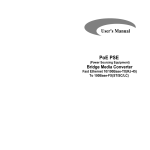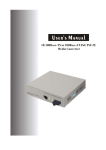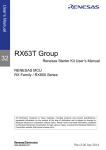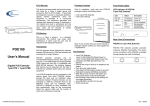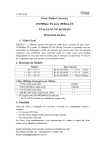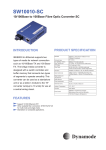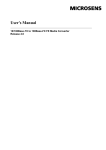Download Alloy POE120 Series Specifications
Transcript
POE120 Series 10/100 Base-TX to 100Base-FX Converter POE Powered Device Version 1.01 Date: 13 July 2005 1. Overview The POE120 Series IEEE 802.3u compliant media converters support two types of media 10/100 Base-TX and 100Base-FX. With LFP (Link Fault Propagation) support it allows the administrator to easily diagnose link faults on their network. If the Copper or Fibre link fails, the converter forces the link status of the connecting device to also fail. The POE120 Series media converters are fully compliant to the IEEE 802.3af standard. The converters advanced auto-sensing algorithm allows the unit to draw power from any IEEE 802.3af Power Sourcing Equipment (PSE) device (POE100 Series Converter, or PoE Switch) or Power over Ethernet Injector. It also supports high levels of safety support with short circuit protection and power-in auto-detection. The POE120 series converters can be powered from either a standard plug pack or a PSE device. 2. Model Description Model POE120 Series Power Description 60mA@-48VDC over Cat.5 100Mbps Fibre Transceiver ST/SC Multimode 2Km SC.S05/S20/S40/S60Km Single Mode SC.S80/S100Km Single Mode Single Fibre Model 1310nm Single Mode 20Km 1550nm Single Mode 20Km Wavelength 1310nm 1310nm 1550nm TX, RX Wavelength TX (Transmit) 1310nm RX (Receive) 1550nm TX (Transmit) 1550nm RX (Receive) 1310nm Note: The 1310nm and 1550nm models must be installed in pairs, i.e., install 1310nm model at one end and the 1550nm model at the other end. 3. Checklist Before you start installing the POE converter, please verify that the package contains the following items. - The POE120 Series Converter CD containing this manual Please notify your sales representative if any of the above items are missing or damaged. 4. Installing the Converter 4.1 POE120 converter connected to a Power Sourcing Equipment Device (PSE) 1. Connect the copper cable to your IEEE 802.3af compliant PSE device. The POE120 can also work as a standard media converter and connect to a non POE device. (power supply is optional) 2. Connect the fibre cable to your connecting device. Note: - Please make sure that the 802.3af power is being supplied from a PSE device to the PD Media Converter. - In case there is no 802.3af PSE available or the PSE device power fails, you may install an AC-DC adapter as a backup solution. Do not connect the PSE Copper port and a AC-DC adapter at the same time. (the power options are not designed in a redundant configuration) Default: Auto Auto or Force setting, see figure 11. S1-Bit 1 TP Attach Cat. 5 cable to the copper port and ensure the cable run is not Port over 100m in distance. The Copper port supports Auto MDI-X, therefore there is no need to use a cross-over cable when connecting to a switch. Fibre Default: 100FDX Port ”100FDX”/”100HXD” setting, see figure 11. S1-Bit 5 Fig. 1 View of the POE120 Series Media Converter Fig. 2 Example connection between POE120, PSE device and Fibre Cable 100FX Fibre Network RX TX TX RX POE120 Series Media Converter AC PoE PSE or PoE Injector Fig. 3 POE120 Series to PSE Device or POE Injector POE1 20 Series 10/ 100 Base- TX to 100Base- FX Fig. 4 POE120 Series Media Converter Front Panel Fig. 5 POE120 Series Media Converter Rear Panel Fig. 6 Pairs used for receiving power over Ethernet Cable. Note: The pins used for receiving power from a PSE Device follows the IEEE 802.3af standard. Endpoint: -48V via TP pins 1, 2, 3, 6 Midspan: - 48V via pins 4, 5, 7, 8 5. WDM Single Fibre Model The POE120 Series media converter has an optional Wavelength Division Multiplexing (WDM) Model that can transport bi-directional full duplex signals over a single fibre simultaneously. Single Fibre Model 1310nm Single Mode 20Km 1550nm Single Mode 20Km TX, RX Wavelength TX (Transmit) 1310nm RX (Receive) 1550nm TX (Transmit) 1550nm RX (Receive) 1310nm Note: The 1310nm and 1550nm models must be installed in pairs, i.e., install 1310nm model at one end and the 1550nm model at the other end. 6. Link Failure Propagation The POE120 Series media converters support Link Failure Propagation (LFP). If the Copper port is unplugged, the converter stops transmission on the fibre port. This causes the remote fibre node link to fail as well. The LED’s on the converter will now show link failure on both the copper and fibre ports. If the fibre link fails, the converter restarts auto-negotiation on the copper port but always stays in the link failure state. This causes the remote copper node link to fail as well. The LED’s on the converter will now show link failure on both the copper and fibre ports. Refer to Fig. 7 shown below for the normal status when link is active. Also refer to Fig. 8 and Fig. 9 for the LED status when copper Cable A, Fibre Cable B or Fibre Cable C fails. Note: The Link Failure Propagation (LFP) function only takes effect when S1-Bit4 (see Fig. 11) is enabled. When S1-Bit4 is disabled the media converter will function normally. 10/100 Switch TP ● ● ● A B LFP LFP C Fibre Cable 10/100 Switch Remote Station TP ● ● ● Fig. 7 Normal Status via a pair of LFP’s 10/100 10/100 Switch Switch A B LFP LFP TP TP C Fibre Cable ● ○ ○ ○ ○ ○ ● Remote Station ● Fig. 8 The Status when Copper Cable A link is broken 10/100 Switch LFP TP ○ ○ ○ B C LFP A 10/100 Switch Remote Station TP Fibre Cable ○ ○ ○ ● Fig. 9 The Status when Fibre Cable C or B link is broken Note : ● ○ indicates LNK/ACT LED Lit indicates LNK/ACT LED Off 7. LED Description The following table describes the LED’s located on the POE100 Series media converter. LED Colour FX LNK/ACT Green FX FDX/COL Amber TP LNK/ACT Green TP 100 Green PWR POE Green Green Function Lit when fibre connection has link Blinks when fibre data is present Lit when full-duplex mode is active Off when half-duplex is active Blinks when collision is present Lit when Copper connection has link Blinks when Copper data is present Lit when Copper speed is 100Mbps Off when Copper speed is 10Mbps Lit when +5V power is supplied Lit when POE power is supplied 8. DC Jack and AC-DC Power Converter The DC jacks central post is 2.5mm wide. DC Jack DC Input : : 2.5mm +5V Fig. 10 DC+5V Input Jack and Dimension 9. DIP Switch Configuration Fig. 11 Reset button and S1 – Bit 1, 2, 3, 4, 5, 6, Configuration and Settings Reset S1-1 TP Port Mode S1-2 TP Port Speed S1-3 TP Port Duplex S1-4 LFP S1-5 Fibre Port Duplex S1-6 POE ON/OFF : If S1-1, S1-2, S1-3, S1-4 or S1- status is changed, please press this button for your settings to take effect. : AUTO(Default) or FORCE : 100 or 10 when TP at Force : FDX or HDX when TP at Force : LFP Enabled (Default) or Disabled : 100FDX (Default) or 100HDX : Enabled (Default) or Disabled Note: 1. S1-2 and S1-3 will take effect only when S1-1 is set to TP-Force 2. S1-5 must be set to 100FDX for Single Fibre Model 3. S1-6 must be set to POE when you need to supply power to a PD. Warning: - When a Copper port set to AUTO and is connected to a device that is Forced to 100Mbps FDX , instead of a device running NWAY, it may result in the devices connecting in HDX mode, this may cause packet collisions on your network. - Please ensure that all network nodes that this device connects to are set to the same mode at each end of the link. e.g., Both ends are set to Auto-Negotiation mode (AUTO) 10. Cable Distances and Limitations - TP Cable Limitations: Cat 5 up to 100m Fibre Cable Limitations: SC/ST Converter Models Multi Mode Half Duplex 412m Multi Mode Full Duplex 2Km Single Mode Half Duplex 412m Single Mode Half Duplex 5/20/40/60/80/100Km 11. Technical Specifications IEEE 802.3u 10/100Base-TX, 100Base-FX IEEE 802.3af Power Over Ethernet Cat. 5 cable up to 100m UTP Cable: 50/125, 62.5/125 or 100/140 µm multi mode Fibre Cable: 8.3/125, 8.7/125, 9/125 or 10/125 µm single mode “Endpoint” Via TP Pins 1, 2, 3 and 6 Power Reception ”Midspan” Via TP pins 4, 5, 7 and 8 Support: Power, POE, TP LNK/ACT, 100, FX LNK/ACT, LED Indicators: FDX/COL 100Mbbps – 148,800pps Data Transfer Rate: 10Mbps – 14,880pps IEEE 802.3x compliant for Full Duplex Flow Control: Backpressure flow control for Half Duplex Power Requirements: 60mA@-48VDC from IEEE 802.3af PSE or POE Injector Ambient Temperature: 0º to 50º C 5% to 90% Humidity: 26.2(H) x 70.3(W) x 94(D) mm Dimensions: Complies with C-Tick, FCC Part 15 Class A and CE Mark Standards:










